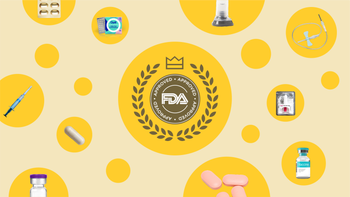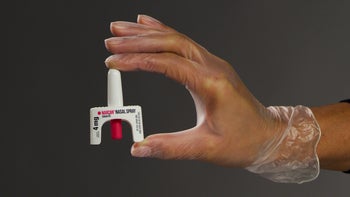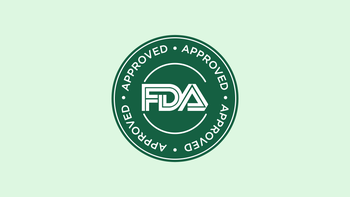
What to Know About Narcan: How It Works, How to Use It, and More
Key takeaways:
Narcan (naloxone) is a fast-acting medication that can treat an opioid overdose. It’s a nasal spray that’s available as generic and brand-name products. Generic naloxone also comes as an injection. You can get Narcan nasal spray with a prescription or over the counter.
The typical Narcan dosage is one spray in one nostril at the first sign of an overdose. If the person isn’t responding within 2 to 3 minutes, administer another dose of Narcan. Call 911 after giving the first dose.
If you think someone around you is experiencing a drug overdose, it’s a good idea to administer Narcan even if you don’t know whether opioids caused the overdose. Narcan is safe to use even if the person receiving it isn’t experiencing an opioid overdose.
Narcan is available both with and without a prescription. And it’s available for free in many states. If you can’t find it for free, GoodRx can help you save over 70% off the average retail price of generic Narcan at certain pharmacies.
Table of contents

Narcan (naloxone) is a medication that can reverse the effects of an opioid overdose. This nasal spray is available with a prescription and over the counter. Narcan comes as both a brand-name and generic medication. What’s more, generic naloxone is also available in an injectable form.
Narcan can be lifesaving when used quickly and effectively. But there’s a few things you should know, like how Narcan works, what it’s used for, and how to administer it. Below, we cover seven frequently asked questions about Narcan.
1. How does Narcan work?
Narcan is an opioid antagonist. Simply put, it blocks the effects of opioids.
Opioids activate opioid receptors (binding sites) throughout your body — like a key fitting into a keyhole. Opioids provide pain relief primarily by binding to a specific type of opioid receptor called the mu receptor. The mu receptor also helps regulate many other bodily functions, including your breathing and heart function.
If you take large amounts of opioids, your breathing rate can become dangerously slow. And you may experience a loss of consciousness. This is where Narcan can be life-saving. Narcan can reverse the effects of opioids by displacing them from (forcing them off of) the mu receptor. Once Narcan kicks in, breathing and consciousness may return.
2. What is Narcan used for?
Narcan is used to reverse an opioid overdose. It has no other uses.
If you think someone is experiencing a drug overdose, you should administer Narcan if it’s available. This is true even if you aren’t sure whether opioids caused the overdose. Narcan won’t cause harm even if opioids weren’t involved. But if they were involved, Narcan could save their life.
Signs of an opioid overdose include:
Loss of consciousness
Slowed or irregular breathing
Slowed heart rate
Choking or gurgling sounds
Blue or grayish skin
Vomiting
Limp body
3. What is the recommended Narcan dosage?
Narcan and its generic version come as a 4 mg nasal spray. The typical Narcan dosage is one spray in one nostril at the first sign of an overdose. Each individual nasal spray bottle only contains one spray (one dose).
Generic naloxone also comes as a 0.4 mg per mL and 1 mg per mL injection. Pre-filled syringes are available and may be the most convenient option to administer. You should inject one dose into a muscle or beneath the skin of the person having an overdose.
If the person doesn’t respond within 2 to 3 minutes, administer a second dose of Narcan or injectable naloxone. Continue administering a dose every 2 to 3 minutes until the person responds or resumes breathing.
Keep in mind that Narcan isn’t a medication you’d administer to yourself. A person experiencing an opioid overdose is typically unresponsive. Narcan is a medication you’d be giving to someone else.
Good to know: Naloxone is also available in other doses and dosage forms. For example, Zimhi comes as a 5 mg auto-injector. Discuss the available naloxone options with a medical professional or pharmacist.
4. How do you administer Narcan nasal spray?

To administer Narcan nasal spray in an overdose situation, follow the 6 steps below:
Lay the person on their back. Try yelling their name or saying, “Wake up!” You can also grasp their shoulders and shake them gently. If they don’t respond to your voice or touch, continue to step 2.
Tilt the person’s head back with your hand, supporting the back of their neck.
Hold Narcan in the correct position before administering it. After removing Narcan from the box, hold it with your thumb on the bottom of the plunger. Your index and middle fingers should be on either side of the nozzle.
Place the nozzle into one nostril. You’ll know it’s far enough into the nostril when your fingers on both sides of the nozzle are resting against the bottom of the person's nose.
Press down on the plunger firmly. This will release a dose of Narcan.
Roll the person to their side. You can put their hands underneath their head for support. Let their top knee fall forward so they don’t roll onto their stomach.
After you’ve administered a dose of Narcan, call 911. Let them know you’re with someone who may have overdosed. Stay with the person until 911 arrives.
If 2 to 3 minutes have passed and the person is still unresponsive, follow steps 1 through 6 above to administer another dose of Narcan. Continue repeating this every 2 to 3 minutes until the person responds or emergency help has arrived.
It’s a good idea to initiate CPR if you’ve been trained on how to do it. If you don’t know CPR, give two rescue breaths every five seconds until help arrives. It’s OK to temporarily pause CPR or rescue breaths to administer additional doses of Narcan.
Note: The instructions for administering naloxone vary between dosage forms. It’s a good idea to review how to administer your chosen naloxone product with a pharmacist or medical professional.
5. What are the side effects of Narcan?
Some common side effects of Narcan nasal spray include:
Temporary increase in blood pressure
Constipation
Toothache
Muscle spasms or pain
Headache
Dry nose
Nasal pain, swelling, or congestion
Dry skin
Since Narcan blocks the effects of opioids, they can cause a person’s pain to return if they regularly use opioids. Narcan can also cause opioid withdrawal symptoms. Opioid withdrawal can be painful or uncomfortable, but it isn’t usually life-threatening.
Opioid withdrawal symptoms may include:
Nausea and vomiting
Yawning
Shortness of breath
Heart palpitations
Blurry vision
Agitation or restlessness
Anxiety
Runny nose
Muscle aches
Diarrhea
Abdominal pain
Goosebumps
Sweating and chills
Opioid withdrawal is best treated by a medical professional. This is just one reason it’s important to call 911 after administering a dose of Narcan. Paramedics and other healthcare professionals can provide the proper care needed to help manage withdrawal symptoms.
6. How fast does Narcan work?
Narcan starts working within a few minutes. Clinical studies have found that most people respond to Narcan nasal spray about 3 minutes after a dose is administered. Naloxone that’s injected into a muscle typically works within about 2 to 5 minutes.
If Narcan isn’t working 2 to 3 minutes after a dose, administer another dose. You’ll know the medication is working if the person becomes responsive or starts breathing again.
7. How long does Narcan last?
Narcan’s effects can last anywhere between 30 to 90 minutes. Some opioids last longer in the body than this. So, it’s possible that a person may respond to Narcan, but have it wear off before emergency help arrives. If the person stops breathing again or becomes unconscious at any point while you’re waiting for help to arrive, provide another Narcan dose.
How to save on Narcan
There’s been a lot of focus on making Narcan as accessible to the public as possible. It’s available OTC, and you can buy Narcan without a prescription all over the U.S. But getting Narcan filled with a prescription can offer you more ways to save.
Generic Narcan is covered by many insurance plans for low or no copays. This includes most Medicare and many Medicaid plans. But if you’re uninsured or underinsured, there are still some ways to save.
Get it for free. Some states, cities, and counties have programs offering Narcan for free. And some public health and nonprofit organizations also distribute Narcan for free.
Save with GoodRx. If you can’t get generic Narcan for free, GoodRx can help you save over 70% off the average retail price. The generic Narcan price at certain pharmacies is as low as $23.44 with a free GoodRx discount.
The bottom line
Narcan (naloxone) is a life-saving medication that’s used to reverse opioid overdose. It’s a nasal spray that works within a few minutes. Naloxone is also available as an injectable medication. The typical Narcan nasal spray dosage is one spray in one nostril at the first sign of an overdose. If the person isn’t responding within 2 to 3 minutes, administer another dose. Call 911 after giving the first dose of Narcan.
If you think someone is experiencing a drug overdose, administer Narcan if you have it. Even if you don’t know whether opioids caused the overdose, you should use Narcan. It won’t hurt the person if opioids weren’t involved. And if they were involved in the overdose, Narcan could save their life.
Narcan comes as both a brand-name and generic medication. It’s available over the counter or with a prescription. In many states, you can find it for free or at a low cost.
Why trust our experts?


If you or someone you know struggles with substance use, help is available. Call SAMHSA’s National Helpline at 1-800-662-4357 to learn about resources in your area.
References
BPI Labs LLC. (2023). Naloxone hydrochloride [package insert].
Emergent Devices Inc. (2023). Narcan [package insert].
HF Acquisition Co. LLC, doing business as Health First. (2023). Naloxone hydrochloride injection [package insert].
HF Acquisition Co. LLC, doing business as Health First. (2023). Naloxone hydrochloride nasal spray [package insert].
Insys Development Company, Inc. (2016). Naloxone for Treatement of Opioide Overdose. U.S. Food and Drug Administration.
Jordan, M. R., et al. (2023). Naloxone. StatPearls.
Legislative Analysis and Public Policy Association. (2020). Naloxone access: Summary of state laws.
National Harm Reduction Coalition. (n.d.). Opioid overdose basics.
National Institute on Drug Abuse. (2021). Naloxone DrugFacts. National Institutes of Health.
Office of Inspector General. (2020). CMS should pursue strategies to increase the number of at risk beneficiaries acquiring naloxone through Medicaid. U. S. Department of Health & Human Services.
Office of the Surgeon General. (2022). U.S. surgeon general’s advisory on naloxone and opioid overdose.
Schiller, E. Y., et al. (2023). Opioid overdose. StatPearls.
Washington State Department of Health. (2019). Naloxone instructions.
Was this page helpful?
Related Articles
Browse medications
View AllResearch prescriptions and over-the-counter medications from A to Z, compare drug prices, and start saving.























